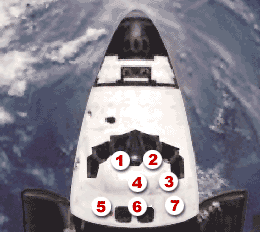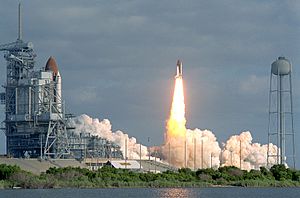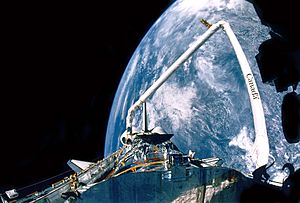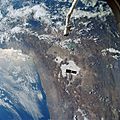STS-31 facts for kids
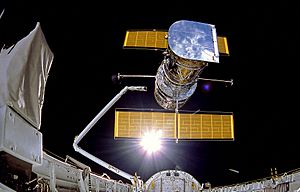
Discovery deploys the Hubble Space Telescope.
|
|
| Names | Space Transportation System-35 STS-31R |
|---|---|
| Mission type | Hubble Space Telescope deployment |
| Operator | NASA |
| Mission duration | 5 days, 1 hour, 16 minutes, 6 seconds (achieved) |
| Distance travelled | 3,328,466 km (2,068,213 mi) |
| Orbits completed | 80 |
| Spacecraft properties | |
| Spacecraft | Space Shuttle Discovery |
| Launch mass | 117,586 kg (259,233 lb) |
| Landing mass | 85,947 kg (189,481 lb) |
| Payload mass | 11,878 kg (26,187 lb) |
| Crew | |
| Crew size | 5 |
| Members |
|
| Start of mission | |
| Launch date | 24 April 1990, 12:33:51 UTC |
| Rocket | Space Shuttle Discovery |
| Launch site | Kennedy Space Center, LC-39B |
| Contractor | Rockwell International |
| End of mission | |
| Landing date | 29 April 1990, 13:49:57 UTC |
| Landing site | Edwards Air Force Base, Runway 22 |
| Orbital parameters | |
| Reference system | Geocentric orbit |
| Regime | Low Earth orbit |
| Perigee | 613 km (381 mi) |
| Apogee | 615 km (382 mi) |
| Inclination | 28.45° |
| Period | 96.70 minutes |
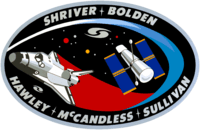 STS-31 mission patch 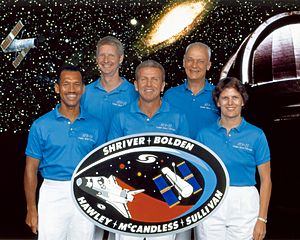 Charles F. Bolden Jr., Steven A. Hawley, Loren J. Shriver, Bruce McCandless II, Kathryn D. Sullivan |
|
STS-31 was a special space mission by NASA. It was the 35th flight of the Space Shuttle program. The main goal was to put the amazing Hubble Space Telescope (HST) into orbit around Earth.
The mission used the Space Shuttle Discovery. This was the tenth flight for this particular shuttle. Discovery launched from Kennedy Space Center in Florida. The launch happened on April 24, 1990.
After the Challenger accident, NASA changed how they numbered missions. Some flights got an "R" added to their name. This helped avoid confusion with older mission numbers.
The crew of Discovery successfully launched the Hubble Space Telescope. This happened on April 25, 1990. For the rest of their trip, the astronauts worked on science experiments. They also used special IMAX cameras. These cameras recorded the mission for a film.
This launch was also special because two Space Shuttles were on the launch pads at the same time. Discovery was on one pad. Columbia was on another, getting ready for its own mission.
Contents
Meet the Astronauts
The STS-31 mission had a crew of five brave astronauts. Each person had an important role to play.
| Position | Astronaut | |
|---|---|---|
| Commander | Loren J. Shriver Second spaceflight |
|
| Pilot | Charles F. Bolden Jr. Second spaceflight |
|
| Mission Specialist 1 | Bruce McCandless II Second and last spaceflight |
|
| Mission Specialist 2 | Steven A. Hawley Third spaceflight |
|
| Mission Specialist 3 | Kathryn D. Sullivan Second spaceflight |
|
Where the Crew Sat
The astronauts had specific seats for launch and landing. The first four seats were on the flight deck. The other seats were on the mid-deck.
- S1: Shriver (Launch and Landing)
- S2: Bolden (Launch and Landing)
- S3: McCandless (Launch), Sullivan (Landing)
- S4: Hawley (Launch and Landing)
- S5: Sullivan (Launch), McCandless (Landing)
Mission Highlights
STS-31 launched on April 24, 1990. The launch had been delayed once before. On April 10, the launch was stopped because of a faulty valve. This valve was in a part called the auxiliary power unit (APU). Engineers fixed the problem and recharged Hubble's batteries.
On the actual launch day, there was a brief stop at T-31 seconds. This was because a fuel valve on the ground equipment did not close automatically. Engineers quickly closed it by hand, and the countdown continued.
Deploying the Hubble Space Telescope
The main goal of STS-31 was to deploy the Hubble Space Telescope. Hubble is a very special telescope. It was designed to work high above Earth. This way, it can see stars and galaxies clearly. Earth's atmosphere can make things blurry for telescopes on the ground.
Hubble observes objects using different types of light. These include ultraviolet, visible, and near-infrared light. The Hubble mission was a big project. It was a team effort between NASA and the European Space Agency (ESA). They had been planning it since the late 1970s.
To make sure Hubble could stay in orbit for a long time, Discovery went into a very high orbit. It reached about 613 × 615 km (381 × 382 mi) above Earth. At one point, Discovery even reached 621 km (386 mi). This was the highest altitude a Space Shuttle had ever reached! This high view allowed the crew to take amazing photos of Earth. They could see large land features that are hard to spot from lower orbits.
Onboard Experiments and Activities
The astronauts used two IMAX cameras during the mission. One was in the cargo bay. The other was handheld inside the shuttle. The footage they captured was used in the 1994 IMAX film Destiny in Space.
The crew also did several science experiments. These included studies on medical technology and advanced materials. They also measured tiny particles and radiation. One student science project looked at how zero gravity affects electric arcs.
Because Discovery was in such a high orbit, its return to Earth was special. The engines had to fire for almost five minutes. This was the longest deorbit burn in Space Shuttle history at that time. Discovery orbited Earth 80 times during the mission.
A Moment of Suspense
During Hubble's deployment, one of its solar arrays got stuck. It stopped unfolding! Ground controllers tried to fix it from Earth. Meanwhile, astronauts Bruce McCandless and Kathryn Sullivan got ready for a spacewalk. They were preparing in case they needed to go outside and fix it.
Luckily, the solar array eventually came free. Ground control was able to unfold it completely. McCandless and Sullivan did not need to go on the spacewalk. They were already inside the airlock, getting ready.
Other Payloads and Experiments
Besides the IMAX cameras, other experiments were on board.
- The Ascent Particle Monitor (APM) checked for tiny particles in the cargo bay.
- Protein Crystal Growth (PCG) studied how protein crystals grow in microgravity.
- Radiation Monitoring Equipment III (RME III) measured radiation levels inside the shuttle.
- Investigations into Polymer Membrane Processing (IPMP) looked at how to control tiny holes in special membranes in space.
- The Air Force Maui Optical Site (AMOS) experiment was also part of the mission.
One unique experiment involved a human skull. It was part of the "In-flight Radiation Dose Distribution (IDRD)" experiment. This project studied how radiation enters the human head in space. The skull was a female skull. It was cut into ten layers and placed in a plastic material. Hundreds of tiny dosimeters were put inside the skull. These devices recorded radiation levels at different depths. This experiment also flew on other shuttle missions.
Landing Back Home
Discovery landed safely at Edwards Air Force Base in California. This happened on April 29, 1990. The landing was smooth. It was also the first time carbon brakes were used on a Space Shuttle. Discovery rolled for about 2,705 m (8,875 ft) and stopped in 61 seconds. The shuttle was then returned to the Kennedy Space Center on May 7, 1990.
Wake-up Calls
NASA has a fun tradition for astronauts. They play music to wake them up in space! This started during the Project Gemini missions. The first time it was used to wake up a crew was during Apollo 15. The songs are often chosen by the astronauts' families. They usually have a special meaning or relate to the day's activities.
- Day 2: "Space is Our World" by Private Numbers
- Day 3: "Shout" by Otis Day and the Knights
- Day 4: "Kokomo" by Beach Boys
- Day 5: "Cosmos" by Frank Hayes
- Day 6: "Rise and Shine" by Raffi
Gallery
-
High over Cuba
-
Hubble drifts away over Peru.
-
Florida and The Bahamas
See also
 In Spanish: STS-31 para niños
In Spanish: STS-31 para niños


